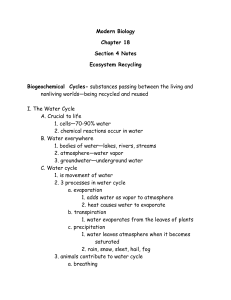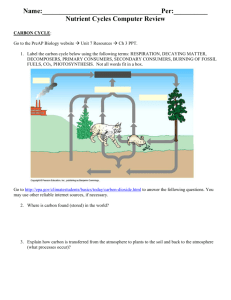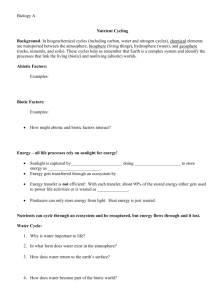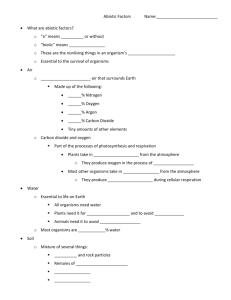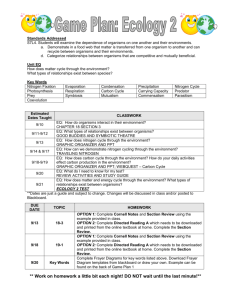Part C 11. cyanobacteria 12. condensation 13. crust 14. sun 15. core
advertisement
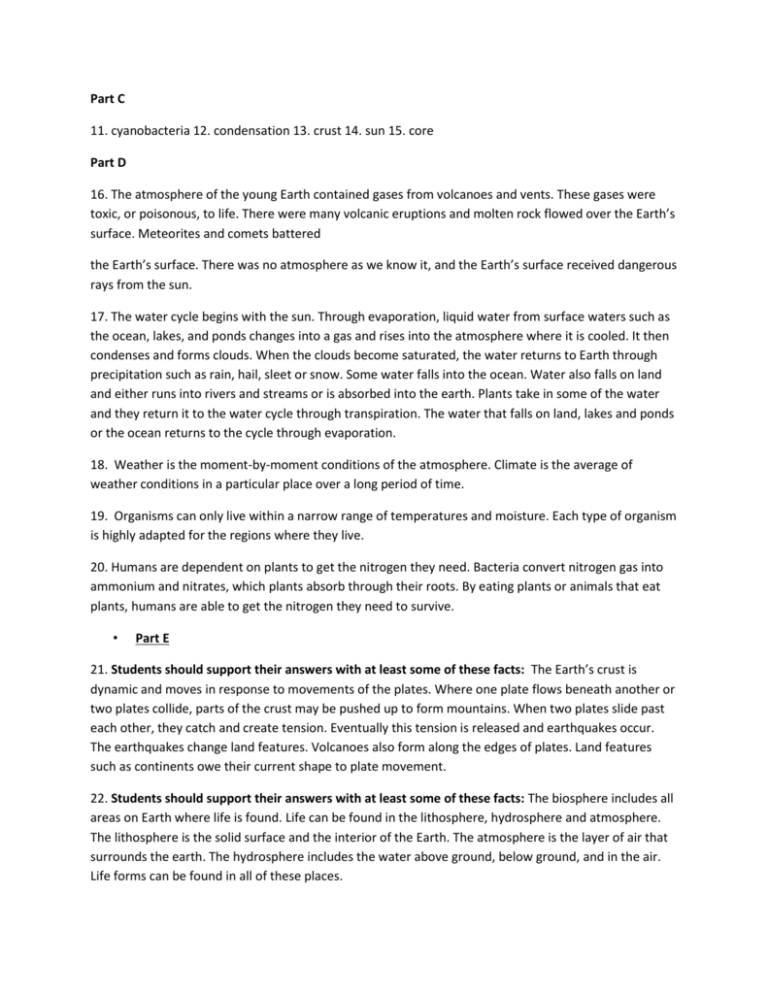
Part C 11. cyanobacteria 12. condensation 13. crust 14. sun 15. core Part D 16. The atmosphere of the young Earth contained gases from volcanoes and vents. These gases were toxic, or poisonous, to life. There were many volcanic eruptions and molten rock flowed over the Earth’s surface. Meteorites and comets battered the Earth’s surface. There was no atmosphere as we know it, and the Earth’s surface received dangerous rays from the sun. 17. The water cycle begins with the sun. Through evaporation, liquid water from surface waters such as the ocean, lakes, and ponds changes into a gas and rises into the atmosphere where it is cooled. It then condenses and forms clouds. When the clouds become saturated, the water returns to Earth through precipitation such as rain, hail, sleet or snow. Some water falls into the ocean. Water also falls on land and either runs into rivers and streams or is absorbed into the earth. Plants take in some of the water and they return it to the water cycle through transpiration. The water that falls on land, lakes and ponds or the ocean returns to the cycle through evaporation. 18. Weather is the moment-by-moment conditions of the atmosphere. Climate is the average of weather conditions in a particular place over a long period of time. 19. Organisms can only live within a narrow range of temperatures and moisture. Each type of organism is highly adapted for the regions where they live. 20. Humans are dependent on plants to get the nitrogen they need. Bacteria convert nitrogen gas into ammonium and nitrates, which plants absorb through their roots. By eating plants or animals that eat plants, humans are able to get the nitrogen they need to survive. • Part E 21. Students should support their answers with at least some of these facts: The Earth’s crust is dynamic and moves in response to movements of the plates. Where one plate flows beneath another or two plates collide, parts of the crust may be pushed up to form mountains. When two plates slide past each other, they catch and create tension. Eventually this tension is released and earthquakes occur. The earthquakes change land features. Volcanoes also form along the edges of plates. Land features such as continents owe their current shape to plate movement. 22. Students should support their answers with at least some of these facts: The biosphere includes all areas on Earth where life is found. Life can be found in the lithosphere, hydrosphere and atmosphere. The lithosphere is the solid surface and the interior of the Earth. The atmosphere is the layer of air that surrounds the earth. The hydrosphere includes the water above ground, below ground, and in the air. Life forms can be found in all of these places. • Part F 23. Answers will vary. Students’ paragraphs should include at least some of these ideas: The water cycle begins with the sun. Water evaporates from the earth’s surface, changing from a liquid into a gas. It then and rises into the atmosphere where it is cooled. Cooling causes water vapor to condense and forms clouds. When the clouds become saturated, the water returns to the Earth through precipitation such as rain, hail, sleet or snow. Some of water falls into the ocean, some falls on land. Plants take in some of the water and then return it to the cycle through transpiration. Water is also returned to the air by evaporation. In the carbon-oxygen cycle, organisms breathe in oxygen and give off carbon dioxide. Carbon dioxide is taken in by plants during photosynthesis, and oxygen is given off as a by-product. In this way, oxygen and carbon are recycled over and over again. In the nitrogen cycle, bacteria in the soil convert nitrogen into ammonium or nitrates. Plants use their roots to absorb these forms of nitrogen from the soil. Humans and other animals get nitrogen by eating plants or other animals. The nitrogen returns to the soil as animal waste or dead and decaying organisms. Tiny organisms in the soil convert animal waste and return it to the soil. 24. Answers will vary. Students’ paragraphs should include at least some of these ideas: Scientists study Earth’s history using several techniques. They can measure the radioactive elements in rocks to determine their ages. They can also “read” the layers of sedimentary rocks, which are like the pages of a book. Rocks are a permanent record of fossils of organisms that lived in the past. Fossils are preserved traces or remains of plants and animals. The types of organisms found in an area reflect the climate of the area.
